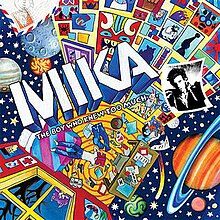The Boy Who Knew Too Much (album)
| The Boy Who Knew Too Much | ||||
|---|---|---|---|---|
 |
||||
| Studio album by Mika | ||||
| Released | 18 September 2009 (see release history) |
|||
| Recorded | June 2008–2009 | |||
| Genre | Pop | |||
| Label | ||||
| Producer | Greg Wells, Imogen Heap, Mika, RedOne | |||
| Mika chronology | ||||
|
||||
| Singles from The Boy Who Knew Too Much | ||||
|
||||
| Professional ratings | |
|---|---|
| Aggregate scores | |
| Source | Rating |
| Metacritic | (70/100) |
| Review scores | |
| Source | Rating |
| AllMusic | |
| The A.V. Club | (A-) |
| Entertainment Weekly | (A) |
| The Guardian | |
| Los Angeles Times | |
| The Observer | |
| PopMatters | |
| Rolling Stone |
|
| Slant |
|
| Spin |
|
| The Times |
|
The Boy Who Knew Too Much is the second studio album by singer Mika. It was released on 21 September 2009, under Casablanca/ Universal Republic in the United States and Island in the United Kingdom.
Mika worked with producer Greg Wells, who also produced his debut album Life in Cartoon Motion. The album was written in Olympic Studios, London, which began in June 2008. In September 2008 he moved to Rocket Carousel Studios, Los Angeles, where the album was recorded. Mika has described the album's themes as dealing with his teenage years, and "in a sense is kind of part two" of his first album. In contrast to his first album, which "contained innocent fairytales", Mika pitches the new album's songs as "gothic Tim Burton-esque fantasies."
The album was originally titled We Are Golden after the first single from the album, "We Are Golden". On 20 July 2009 in an on-air interview with DJ Jo Whiley on BBC Radio 1, Mika revealed he was considering renaming the album, because he wanted "something a little more ridiculous." On 6 August 2009 it was confirmed that the album's title would change to The Boy Who Knew Too Much. As with Mika's debut album Life in Cartoon Motion, the album artwork has been designed by Mika's sister (who works under the nom de plume DaWack), the Australian illustrator Sophie Blackall, Airside collaborator Richard Hogg and Mika himself. The artwork has been inspired by children's picture books from the 1940s to 1970s.
...
Wikipedia
